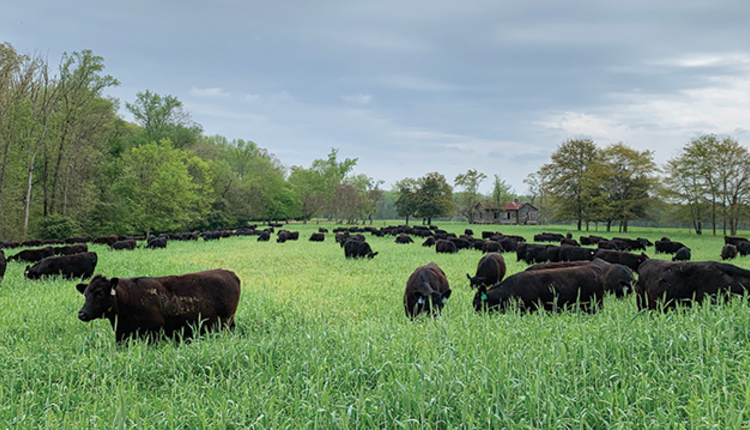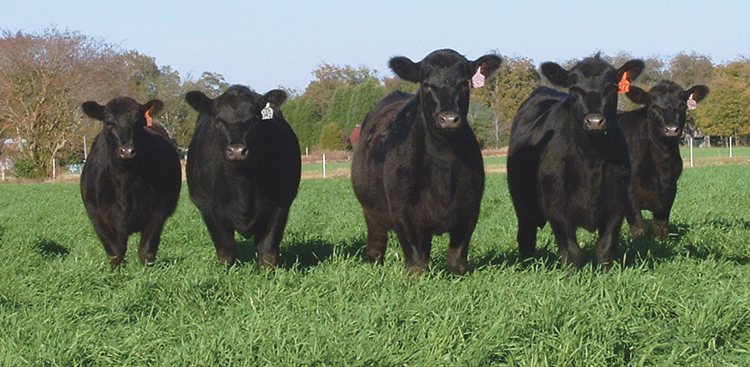
Exceptional cattlemen are not always exceptional forage managers. But when the two enterprises do come together and are firing on all cylinders, it’s a marriage that yields remarkable results.
Remarkable results are what I heard Lydia Yon speak of at a cattlemen’s conference several years ago. I was impressed by the back and front story of Yon Family Farms in Ridge Spring, S.C. The scribble in my notebook read something like this: If in South Carolina, stop at this farm.
I was, and I did.
Descending the long farm driveway, it was easy to discern the presence of high-end cattle and good forage. I would soon learn that this operation had much more to offer in the form of a heaping dose of opportunity, humility, compassion, and a back story that the folks in Hollywood couldn’t even contrive.

“There’s never been anything else I wanted to do,” Kevin Yon said as we sat and visited at the farm’s home base. “Seedstock Angus is our product, but the real profit center is the forages. We just use our Angus cattle to harvest it and give us something that’s saleable,” he added.
Kevin and Lydia Yon have farmed here since 1996. All three of their children and a daughter-in-law are also involved. The current operation is anchored by about 1,600 brood cows, which calve in both the spring (January through March) and fall (September through November). The livestock are supported by several thousand acres of various forage crops. About 450 bulls are sold each year and all of the steers are fed out on-farm.
On the line
“We’ve always been pushed on land space,” Yon explained. “I like developing land to a forage-cattle type system. We’ve converted about every type of land imaginable to forage, including timber and row-crop land.”
There is much about the farm that is unique, but perhaps topping that list is the fact that it lies right on the fall line between the Piedmont Fescue Belt and the Coastal Plain sandhills. “In one direction our pastures are tall fescue, and the other direction they’re bermudagrass and bahiagrass,” Yon noted.
“Toxic fescue is a challenge, but it’s what we have,” he said. “When you’re marketing seedstock, it’s good to know which cattle can tolerate it better than others. We try to mitigate the effect as best we can.”
On the sandy soils, Yon utilizes hybrid bermudagrass, bahiagrass, and crabgrass. In the fall, Yon will no-till winter annuals into his warm-season pastures. This can include combinations of wheat, oats, triticale, ryegrass, and sometimes crimson clover.
“We’ve also got some land that goes from a winter annual to a summer annual with no perennial crops at all,” Yon explained.
Cereal forages provide the backbone for winter pastures. The Yons grow their own triticale, wheat, and oat seed. This ensures a seed supply for the 1,500 acres of small grains that they plant annually.
Multiple forage sources
“We’ve started to use more forage oats lately with some of the new Southern varieties that are coming out of the University of Florida,” Yon said. “We love ryegrass and use improved varieties, but getting a reliable seed supplier is sometimes a challenge.”
For some fields, Yon will triple crop a winter annual, followed by corn, and then plant a summer annual such as sorghum-sudangrass or millet. He utilizes the brown midrib (BMR) trait in some of the corn, sorghums, and millets to achieve higher forage digestibility. The summer annuals are either grazed or made into baleage. He noted that the past couple of years sugarcane aphid has been a problem in the sorghums.
The 500 acres of corn silage grown on the farm are used in the finishing ration and for growing young bulls and heifers during periods when pastures are less productive. They plant the corn themselves, but hire a custom harvester. The corn silage is meticulously packed and stored in bunker silos.
Yon is becoming a big fan of crabgrass. Although an annual, it reseeds itself every year, so some of his fields consist of a winter annual-crabgrass rotation. They currently use a mixture of Red River and Impact crabgrass varieties.
Both tall fescue and bermudagrass are stockpiled to fill the summer-fall transition time period. Yon likes to start limit grazing the winter annuals about the end of October. Those will be grazed through the winter unless it gets so cold that they stop growing or they have wet periods where cattle will do too much damage to the pastures. During these periods, cattle are moved to sacrifice paddocks.
When asked about where legumes fit into the system, Yon explained that they don’t do a lot of overseeding. They will use annual legumes such as crimson clover, which is interseeded in the fall. “We use predominantly poultry litter as fertilizer, and that brings with it some pretty high broadleaf weed pressure, which we control with herbicides,” he said. “As such, it’s hard to keep clover in our stands of grass.”
Perennial legumes are a different story for Yon. He’s been growing alfalfa for the past 20 years, but in the last six years has routinely seeded alfalfa into his bermudagrass stands. It was a second-cutting alfalfa baleage that garnered Yon the grand champion forage trophy at last year’s Southeastern Hay Contest held in Moultrie, Ga. The alfalfa had been no-tilled into a stand of Coastal bermudagrass.
High on baleage

The Yons put up about 8,000 round bales per year, with roughly 40% of those being baleage and the remainder being dry hay, which are primarily bermudagrass. However, if the weather doesn’t cooperate, they will make baleage out of bermudagrass. “Tifton 85 bermudagrass, put up at the right time as baleage, is one of the best forages that we have,” Yon said.
Yon doesn’t make any fescue hay, but he is currently developing some Piedmont land and will plant a novel endophyte variety. “Maybe then we’ll make some fescue hay,” he predicted.
A lot of the baleage is made in March and April out of their surplus of winter-annual forage acres. Their baler is equipped with a precutter to aid incorporation into a total mixed ration (TMR). Also, all of the baleage is inoculated at the baler.
The TMR is used to supplement pastures based on the time of the year and the particular livestock’s nutrient needs. “We want to feed a high-forage ration, usually over 80% forage,” Yon said. “For the bulls, we target 3 pounds of gain per day. We get our energy from corn silage and protein and energy from the small grain baleage.”
Always looking for a better and more economical mouse trap, Yon has recently started to plant some grain sorghum and then harvests it as high-energy sorghum headlage. Once the grain heads are cut and ensiled, he lets the remaining plants tiller and harvests the fodder as baleage.
Finally, Yon will utilize neighboring cotton and other row crop fields for grazeable residue. “We don’t use our crop residues enough as a forage resource,” he opined.
Yon also bales a limited amount of small square bales to sell as a cash crop into the horse market. “I wish we could do more; it’s a good profit center, but we need most of our forage for the cattle,” he said.
Currently, a small percentage of Yon Family Farms is under center pivot irrigation. For a water source, Yon uses a large retention pond. Although the area receives about 50 inches of rain annually, one of Yon’s goals is to get more acres under irrigation, which can be used in times of drought and to help get winter annuals off to a fast start in the fall.
Sustainability rules
“In terms of the farm operation overall, we try to be holistic and sustainable,” Yon said. Going back to 2008, Yon Family Farms was named the National Winner of the prestigious Environmental Stewardship Award, which is administered by the National Cattlemen’s Foundation. Yon has taken advantage of many Natural Resources Conservation Service (NRCS) programs to improve their grazing operation and water conservation practices.
“Using about 2 tons of poultry litter on every field, we never have to buy phosphorus, but we do have to purchase and apply some nitrogen and potassium,” Yon explained. “We also apply lime where it’s needed, and that’s some of the best money we invest.”
On the fescue land, Yon usually doesn’t apply any poultry litter until late spring. “This encourages the summer grasses and helps to dilute the fescue in the heat of summer,” he said.
Family and then some

While operations similar to Yon Family Farms are typically built over generations, Yon is a first-generation farmer. How he and his family got to this point is a story of hard work, some luck, and a group of neighbors who recognized a good farmer when they saw one (see the sidebar “A restroom and some candy”).
“We made a conscious effort to grow the farm so that at least one child could come back if they wanted,” Yon explained. “We also wanted to be big enough to involve more than just family labor. We wanted employees so that we could leave the farm if we needed or wanted to.”
Not only did one child come back to the family farm . . . they all did. “It wasn’t a birthright,” Yon said. “The rule was that they had to stay away for four years, including college. During summers when they didn’t have classes, they had to find work or an internship somewhere else.”
Like their parents, all three of the Yons’ children graduated from Clemson. These days, farm responsibilities are identified, but are not hard and fast, because Yon feels that everyone needs to have a working knowledge of the entire operation.
The youngest son, Corbin, likes the crop farming, even though he also is involved with the cows. The middle child, Drake, does a little of everything, including the feeding and nutrition. His wife, Nicole, is a food science major and is involved in the farm’s budding pecan business and retail store that is located in Ridge Spring.
The Yons’ daughter, Sally, helps with a lot of the marketing and does a great deal of photography and sale videos. The Yons run a genomic test on every calf, and each breeding is done on paper to get the best match.
Yon Family Farms supplies a livelihood to about 12 different families. “We’re very proud of that,” Yon said. “It’s a blessing and a huge responsibility.” The Yons also employ college interns every summer.
The employee pool at Yon Family Farms is diverse. Among the group of workers are old and young, a former Navy Seal, and some who have battled substance addictions. During my visit, three disadvantaged young brothers from a broken home in town were seen clearing brush from a pasture. “We don’t put people in boxes, but take them for what they are and who they are,” Yon explained. “All of them work on our farm because they want to, and we’re willing to give them that chance.”
Yon Family Farms is a large operation by most eastern U.S. standards. It was built on opportunity, hard work, and the synergistic relationship of good cows being intensively grazed on good forage. All three of these building blocks are still readily apparent to anyone who visits the farm today. Much of the opportunity rests in the next generation and those who work on the farm. As for Yon, he remains highly motivated and passionate about cows and people. “I’ve never woke up and wondered if I should be doing something else,” he concluded.
A Restroom and Some Candy
This article appeared in the January 2021 issue of Hay & Forage Grower on pages 26 to 29.
Not a subscriber? Click to get the print magazine

